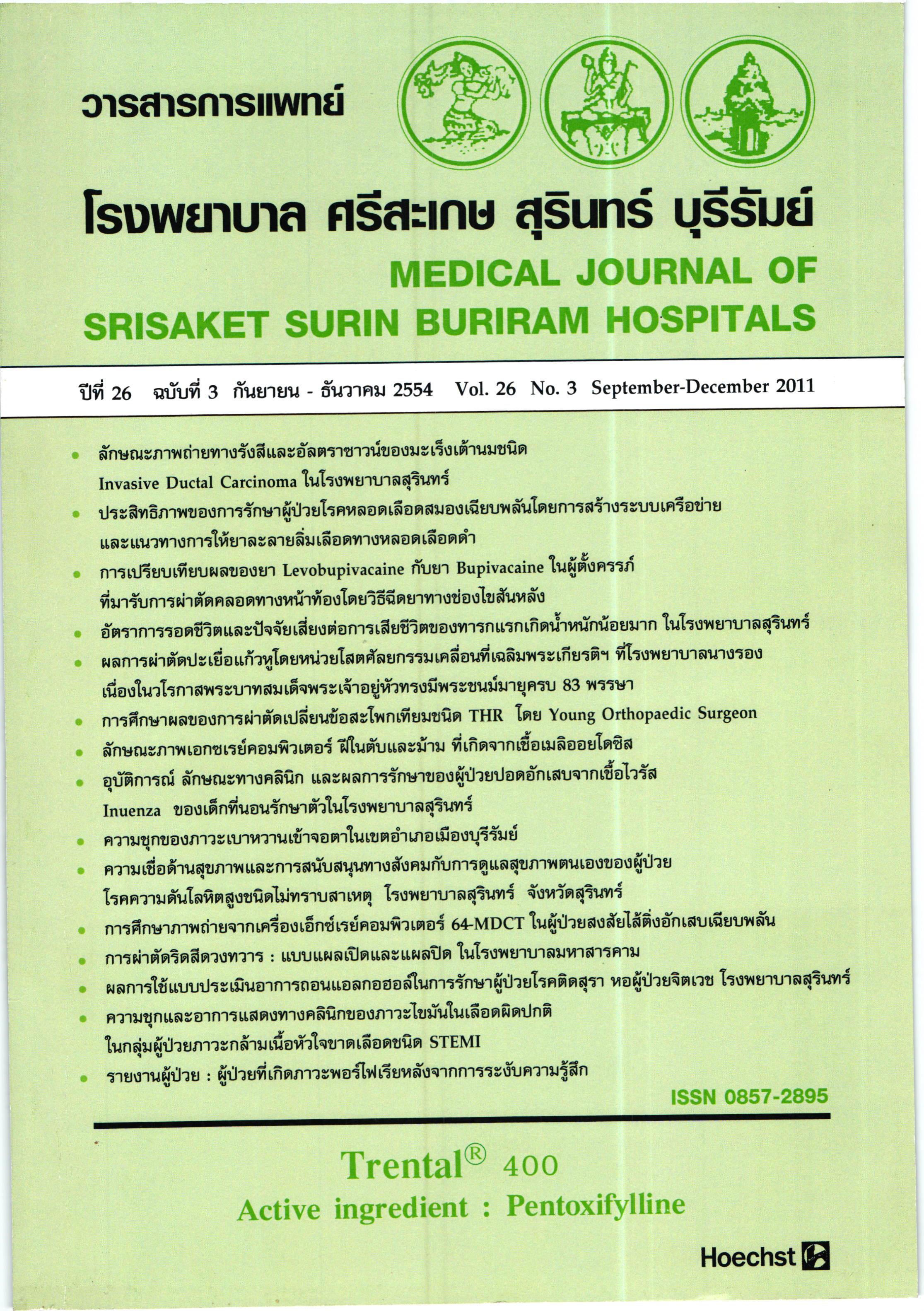ลักษณะภาพถ่ายทางรังสีและอัลตราซาวน์ของมะเร็งเต้านมชนิด Invasive Ductal Carcinoma ในโรงพยาบาลสุรินทร์
Main Article Content
บทคัดย่อ
วัตถุประสงค์: เพื่อศึกษาลักษณะทางรังสีวิทยาจากการตรวจแมมโมแกรมและอัลตราซาวน์ของผู้ป่วยมะเร็งเต้านม ชนิด Invasive ductal carcinoma
สถานที่ศึกษา: โรงพยาบาลสุรินทร์
รูปแบบการวิจัย: การวิจัยเชิงพรรณนา แบบย้อนหลัง
วิธีการศึกษา: ทำการศึกษาย้อนหลังในผู้ป่วยมะเร็งเต้านมชนิด Invasive ductal carcinoma ที่ได้รับการ ตรวจแมมโมแกรม และอัลตราซาวน์ จำนวน 80 ราย ตั้งแต่ 1 มกราคม 2552 - 31 ธันวาคม 2553 โดยผู้ป่วยทุกรายมีผลทางพยาธิวิทยายืนยันว่าเป็นมะเร็งเต้านมชนิด Invasive ductal carcinoma
ผลการศึกษา: จากการศึกษาผู้ป่วยมะเร็งเต้านมชนิด Invasive ductal carcinoma ทีได้รับการตรวจ แมมโมแกรม และอัลตร้าซาวน์ จำนวน 80 ราย พบรอยโรคโดยแมมโมแกรมจำนวน 71 รอยโรคจากผู้ป่วย จำนวน 70 ราย ในจำนวนผู้ป่วย 10 รายที่ไม่พบรอยโรคโดยแมมโมแกรมพบว่ามีผู้ป่วย 5 รายมี ผลแมมโมแกรมปกติ ส่วนที่เหลืออีก 5 ราย ผลการตรวจแมมโมแกรมแสดงแค่การไม่สมมาตร (asymmetrical density) ของเนื้อเต้านมทั้งสองข้าง ลักษณะรูปร่างของมะเร็งเต้านมชนิด Invasive ductal carcinoma ที่พบมากที่สุดจากการตรวจด้วยเครื่องแมมโมแกรมได้แก่ ก้อนที่มีรูปร่าง ผิดปกติไม่สม่ำเสมอ (irregular shape) (84.5%) ลักษณะขอบเขตของมะเร็งเต้านมชนิด Invasive ductal carcinoma ที่พบมากที่สุดจากการตรวจด้วยเครื่องแมมโม-แกรมได้แก่ ลักษณะที่เป็น หนามแหลม (spiculated margin) (36.6%) รองลงมาได้แก่ก้อนที่มีขอบเขตไม่ชัดเจน แยกจาก เนื้อเยื่อข้างเคียงได้ยาก (indistinct or ill-defined margin) (32.4%) พบหินปูนร่วมกับก้อน มะเร็ง ในผู้ป่วย 38 ราย (47.5%) ส่วนมากเป็นชนิดผสมทั้งแบบ granular และ linear, (47.3%) ภาพแมมโมแกรมมีความไวในการตรวจพบหินปูนที่เกิดจากมะเร็งได้ดีกว่าการตรวจด้วยเครื่อง อัลตราซาวน์ ในการศึกษาครั้งนี้ตรวจพบว่ามีการแพร่กระจายของมะเร็งเต้านมชนิด Invasive ductal carcinoma ไปยังต่อมน้ำเหลืองที่รักแร้จำนวน 20 ราย (25%) สำหรับการตรวจเต้านม ด้วยเครื่องอัลตราซาวน์ พบว่ามีความไวในการตรวจหาก้อนมะเร็งได้ดีกว่าการตรวจด้วยเครื่อง แมมโมแกรม โดยเฉพาะเต้านมที่มีความหนาแน่นของเนื้อเต้านมสูง การตรวจด้วยเครื่องอัลตราซาวน์สามารถพบก้อนมะเร็งได้ 81 ก้อน จากผู้ป่วยทั้งหมด 80 ราย ลักษณะรูปร่างของมะเร็งเต้านมชนิด Invasive ductal carcinoma ที่พบมากที่สุดจากการตรวจด้วยเครื่องอัลตราซาวน์ ได้แก่ ก้อนที่มีรูปร่างผิดปกติไม่สม่ำเสมอ (irregular shape) (78.7%) และ ขอบไม่เรียบมีลักษณะ เป็นหนามแหลม (angulated margin) (69.1%) ลักษณะภายในก้อนที่พบมากที่สุดจากการตรวจ ด้วยเครื่อง อัลตราซาวน์ ได้แก่ แบบ low echo และพบเงาหลังรอยโรค (posterior shadowing) 29.6% ส่วน posterior enhancement พบ 28.4%.
สรุป: ลักษณะของมะเร็งเต้านม1ชนิด Invasive ductal carcinoma ที่พบมากที่สุดจากการตรวจด้วย เครื่องแมมโมแกรมได้แก่ ก้อนที่มีรูปร่างผิดปกติไม่สม่ำเสมอ (irregular shape) (84.5%) และ ลักษณะที่เป็นหนามแหลม (spiculated margin) (36.6%) ส่วนลักษณะรูปร่างของมะเร็งเต้านม ชนิด Invasive ductal carcinoma ที่พบมากที่สุดจากการตรวจด้วยเครื่องอัลตราซาวน์ ได้แก่ ก้อนที่มีรูปร่างผิดปกติไม่สม่ำเสมอ (irregular shape) (78.7%) และขอบไม่เรียบมีลักษณะเป็น หนามแหลม (angulated margin) (69.1%) การใช้เครื่องอัลตราซาวน์ตรวจเต้านมร่วมกับการตรวจเครื่องแมมโมแกรมและการตรวจพบลักษณะของมะเร็งเต้านมชนิด Invasive ductal carcinoma อื่นๆ ได้แก่ การพบหินปนในก้อนมะเร็ง, พบต่อมน้ำเหลืองที่รักแร้โต, พบผิวหนังของเต้านมหนาขึ้น หรือ พบการดึงรั้งของหัวนมจากการตรวจเครื่องแมมโมแกรม ทำให้การวินิจฉัย มะเร็งเต้านมมีความแม่นยำมากขึ้น
Article Details
เอกสารอ้างอิง
Center for Disease Control and Prevention National Cancer Data: https://www.cdc.gov/cancer/natlcancerdata.html
American Cancer Society Breast cancer Fact &figures: https://www.cancer.org/statistics/index.html
Attasara P, Srivattanakul P, Sriplung H: Cancer in Thailand vol.5 2001-2003; 7
Berg WA, Gutierrez L, Ness M, Aiver MS et al. Accuracy of mammography, clinical examination, ultrasonography and MR imaging in preoperative assessment of breast cancer: Radiology 2004 Dec; 233(3): 830-849. Epub 2004 Oct 14.
Tohno E, Chapter 9 malignant breast lesion, In: Cosgrove DO, Sloane JP. Ultrasound Diagnosis of Breast Disease. Edinburgh: Churchill Livingstone; 1994.
Tucker AK, Chapter 9 diagnostic mammography, In: Tucker AK. Textbook of Mammography. 1st ed. Churchill Livingstone; 1993.
Zonderland HN, Coerkamp EG, Hermans J, van de Vijver MJ, van Voorthusien AE. Diagnosis of breast cancer: contribution of ultrasonography as an adjunct to mammography: Radiology 1999; 213; 413-422.
Anderson I. Radiographic screening for breast carcinoma III: appearance of breast carcinoma and number of projections to be used at screening. Acta Radiologica Diagn 1981;22:407-420.
Cotran RS, Kumar V, Robbin SL. Robbins: Pathologic Basis of Disease. 5th ed. WB Saunders, 1994.
Gershon-Cohen J, Schorr S. The diagnostic problems of isolated, circum scribed breast tumors: AJR 1969; 106: 863-70.
Breast imaging lexicon, In D’OrsiCJ, Bassett LW, Berg WA, Feig SA et al. American College of Radiology (ACR). Illustrated breast imaging reporting and data system (BIRADS) 4th ed. Reston, VA: American College of Radiology 2003.
Fu KL, Fu YS, Bassett LW, Cardall SY and Lopez JK. Invasive malignancies, In: Bassett LW, Jackson VP, Fu KL and Fu LS. Diagnosis of disease of the breast. 2nd ed. Elserver Saunders, Pen 2005.
Lim ET, O’Doherty A, Hill AD, Quin CM. Pathological axillary lymph nodes detected at mammographic screening: Clinical Radiology 2004 Jan; 5: 86-91
Stavros T, Thickman D, Rapp C, Dennis M, Parker S, Sisney G. Solid Breast Nodules: Use of Sonography to distinguish between Benign and Malignant lesions: Radiology 1995: 196(1); 123-134.
Lamp PM, Perry NM, Vinnicombe SJ, Well CA. Correlation Between Ultrasound Characteristics, Mammographic Findings and Histological Grade in Patient with Invasive Ductal Carcinoma of the Breast: Clinical Radiology 2000 Jan; 55(1):40-4
Rahbar G, Sie AC, Hansen GC, et al. Benign versus malignant solid breast masses: us differentiation: Radiology 1999 Dec;213(3):889-94.
Samardar P, De Paredes ES, Grimes MM. Focal Asymmetric Densities Seen at Mammography: US and Pathologic Correlation: Radiographics 2002 Jan- Feb;22(1):19-33.
Houssami N, Irwig L, Simpson JM, McKessar M, Blome S, Noakes J. Comparative sensitivity and specificity of mammography and sonography in young women with symptoms: AJR 2003 Apr; 180 (4):935-40
Rotstient AH, Neerhut PK. Ultrasound characteristics of histologically proven grade 3 invasive ductal breast carcinoma: Australas Radiol 2005 Dec;49(6):476-9.


